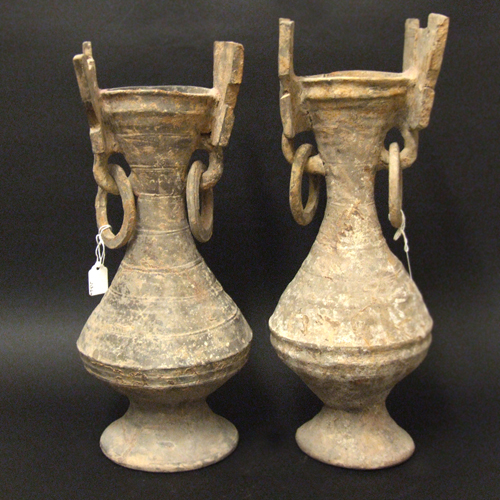
EASTERN ZHOU, Spring and Autumn Period 7th or 6th Century B.C. Eastern Zhou Pottery.
A Pair of Rare Bronze Form Spring and Autumn Period Pottery `Hu` Shaped Vases. Eastern Zhou 770 – 256 B.C, Spring and Autumn Period 770-476 B.C. Bases on a Bronze Form. The Pear Shaped Body with Large Rings Suspended Form Loops Below Cut Flanges in the Form of an Animal or Taotie Masks.
SOLD
- Condition
- In poor condition : Vase One ; section of the neck restuck with associated section of one flange restuck and the handle restuck, the loop extensively restored. The base restuck Vases Two ; section of one flange restuck.
- Size
- Height : 33 cm (13 inches)
- Provenance
- N/A
- Stock number
- 21760
- References
- For a similar Spring and Autumn Period vase see : The Complete Works of Chinese Ceramics Volume 2 (Zhongguo Taoci Quanji Shanghai, 2000. In Chinese only) For a related Spring and Autumn Period vase see : Chinese Ceramics from the Meiyintang Collection, Volume Three (I) (Regina Krahl, Paradou Writing. Apparently undated and without an ISBN number) page 80 and 81, plate 1092.
Information
Spring and Autumn Period 770-476 B.C. :
The Spring and Autumn Period was a period in Chinese history that roughly corresponds to the first half of the Eastern Zhou dynasty (from the second half of the 8th century BC to the first half of the 5th century BC). Its name comes from the Spring and Autumn Annals, a chronicle of the state of Lu between 722 and 479 BC, which tradition associates with Confucius. The period itself lasted from 770 to 476 BC.
During the Spring and Autumn period, China was ruled under a feudal system. The Zhou Dynasty kings held nominal power but only directly ruled over a small royal demesne centred on their capital (modern-day Luoyang). They granted fiefdoms over the rest of China to several hundred hereditary vassal states headed by members of the nobility (Zhūhóu). These were descendants of members of the Zhou clan, close associates of the founders of the dynasty, or local potentates. The most important feudal princes (known later as the twelve vassals, Shíér Zhūhóu), met during regular conferences, where important matters, such as military expeditions against foreign groups or offending nobles, were decided. During these conferences, one vassal leader was sometimes declared hegemon (bó, later bà) or hegemon and given leadership over the armies of all the feudal states.
As the era unfolded, larger and more powerful states annexed or claimed suzerainty over smaller ones. By the 6th century BC, most small states had disappeared, and a few large and powerful principalities dominated China. Some southern states, such as Chu and Wu, claimed independence from the Zhou. Wars were undertaken to oppose some of these states (Wu and Yue). In the state of Jin, six powerful families fought for supremacy, and a series of civil wars resulted in the splitting of Jin into six smaller states by the beginning of the fifth century.
At the same time, the control that the Zhou kings exerted over the feudal princes slowly - but inexorably - faded. Eventually the nominal Zhou kings lost all real influence, the feudal system crumbled, and the Warring States Period began.Information from http://en.wikipedia.org
T.L. Test :
A thermoluminescence (TL) test from Oxford Authentication Ltd supports the dating of this object. See `Links` for more details of the methods used for a thermoluminescence (TL) test and the details of Oxford Authentication Ltd.